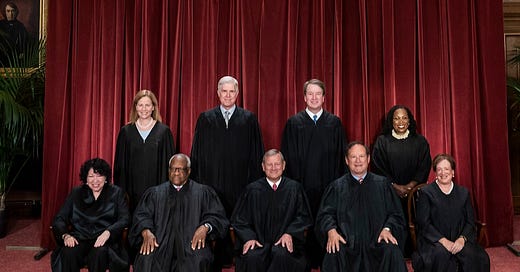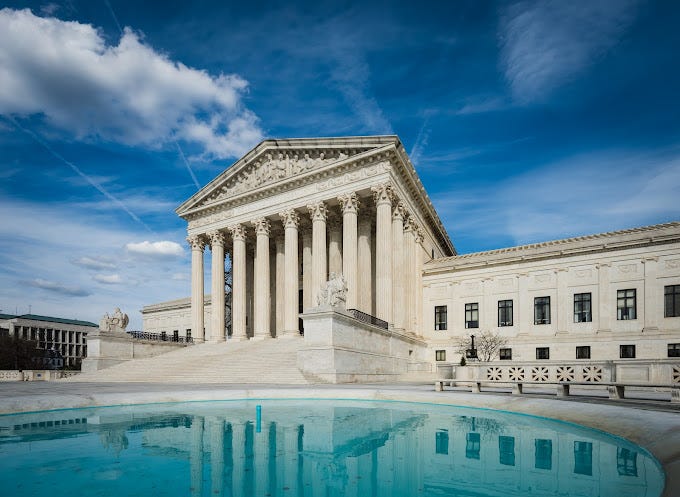US Supreme Court Junks the Chevron Doctrine: A New Era in U.S. Administrative Law
The Demise of the Chevron Doctrine: Shifting Judicial Interpretation in a Post-Chevron Era.
Introduction
Chevron Doctrine RIP
On June 28, 2024, the U.S. Supreme Court delivered a landmark 6-3 decision that overturned the long-standing Chevron doctrine, fundamentally reshaping the landscape of administrative law in the United States. The Chevron doctrine, established in the 1984 case Chevron U.S.A., Inc. v. Natural Resources Defense Council, Inc., had guided courts for four decades to defer to federal agencies' interpretations of ambiguous laws.
Will this verdict apply retrospectively?
Chief Justice Roberts explicitly stated in the majority opinion that the 17,000 lower court decisions and 70 Supreme Court rulings that have used the Chevron doctrine’s precedent will still stand. But federal regulations that aren’t explicitly backed up by clear-cut laws will likely face new legal challenges.
Shift in Power
This decision signifies a pivotal shift in the balance of power between federal agencies, the courts, and Congress. The Chevron principle recognised the expertise of agencies in their respective fields and allowed them to fill in the gaps where congressional statutes were unclear. Essentially, the law in the USA was that in the event a law is ambiguous, the courts should follow the interpretation adopted by the concerned statutory executive agency. Today’s verdict decisively throws the ball back to the courts (pun intended) to interpret these laws in accordance with the Constitution and their own best judgment.
Reaction
Reacting to the judgment, Sean Davis, CEO of The Federalist, tweeted, "BREAKING: In a major blow to the unelected administrative state, the Supreme Court has overruled the Chevron doctrine, which required courts to defer to the legal interpretations of unelected bureaucrats."
The Case and the Majority Opinion
Background of the Case
The recent ruling stemmed from cases involving Atlantic herring fishermen who challenged a National Marine Fisheries Service regulation mandating that they finance onboard observers. Represented by groups linked to the conservative Koch network, the fishermen argued that Congress had not authorised the agency to impose such financial burdens.
Majority Opinion
In the majority opinion, Chief Justice John Roberts articulated that the Chevron doctrine conflicts with the Administrative Procedure Act, which mandates that courts independently interpret the law. Roberts stated, "Chevron was a judicial invention that required judges to disregard their statutory duties." The Court determined that judges should no longer defer to agencies' reasonable interpretations of ambiguous statutes but should instead ascertain the best interpretation of the law themselves, in accordance withe facts and circumstances of the case, subject, of course, to the constitutional provisions.
Implications of the Decision
a.) Shift of Power
This decision shifts interpretive authority from executive agencies to the courts and Congress. Federal judges now hold primary responsibility for interpreting the meaning of laws, especially in their application, a role previously moderated by agency expertise.
b.) Increased Legal Challenges
The ruling is likely to result in an increase in legal challenges against agency regulations as litigants attempt to overturn policies based on judicial interpretations. This surge in litigation could introduce significant uncertainty for industries regulated by these agencies.
c.) Regulatory Challenges
Agencies may find it more challenging to enact regulations on complex issues such as climate change, public health, and consumer protection. They will likely need more explicit statutory authority from Congress to justify their actions, potentially stymieing swift regulatory responses.
d.) Inconsistent Court Rulings
The decision could lead to inconsistent interpretations of statutes by different judges, creating compliance challenges for businesses operating across various jurisdictions. As Kevin King, an appellate lawyer, noted, this could result in "geographic uncertainty," with liberal-leaning courts in California interpreting statutes differently from conservative-leaning courts in Texas.
Impact on Start-ups
a.) Uncertain and Litigious Environment
For start-ups, the impact will vary by industry and applicable regulations. Those in heavily regulated sectors like healthcare, energy, or finance may face a more uncertain and litigious environment, requiring increased expenditure on legal compliance and defence against potential lawsuits challenging agency rules.
b.) Potential Benefits
Conversely, some argue that limiting agency power could benefit businesses by reducing regulatory overreach. Start-ups innovating in areas like cryptocurrency or new technologies might encounter fewer regulatory barriers if agency authority is restricted by judicial interpretations.
Perspectives from the Bench
Dissenting Opinion
The Court's three liberal justices—Sonia Sotomayor, Elena Kagan, and Ketanji Brown Jackson—dissented. Justice Kagan's dissent emphasised that the majority's decision would make the Supreme Court and lower courts the final arbiters on regulatory matters in which they lack expertise. She stated, "In every sphere of current or future federal regulation, expect courts from now on to play a commanding role. It is not a role Congress has given them... It is a role this court has now claimed for itself, as well as other judges."
Concerns About Expertise
Justice Kagan further argued that federal agencies possess the necessary expertise to interpret ambiguous regulations involving technical subjects. "Agencies often know things about a statute’s subject matter that courts could not hope to," she wrote. "Agencies are staffed with ‘experts in the field’ who can bring their training and knowledge to bear on open statutory questions."
Summing Up and Looking Forward
The Supreme Court's repudiation of Chevron deference marks a significant reconfiguration of the interplay between agencies, courts, and Congress. The long-term ramifications of this decision will unfold as lower courts navigate the new judicial landscape. This ruling not only curtails federal agency power but also sets the stage for a dynamic and potentially contentious era in U.S. administrative law.
Regulators have often been hesitant to provide advanced rulings, and when they did, these were frequently narrow interpretations that elevated regulation to the level of strangulation. This verdict has been welcomed by those advocating for a liberalised operating environment. However, it remains to be seen whether the diminished regulatory power will lead to more freedom or merely replace the influence of regulators with the tyranny of the unelected. These are early days, and the full impact of the decision will reveal itself over time.
If you believe this article would interest someone you know, please feel free to share it anonymously (for us), using any platform that you prefer.






